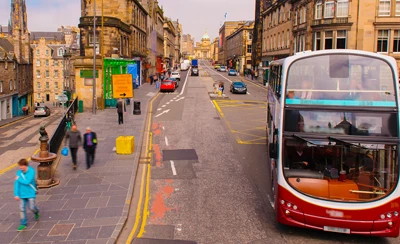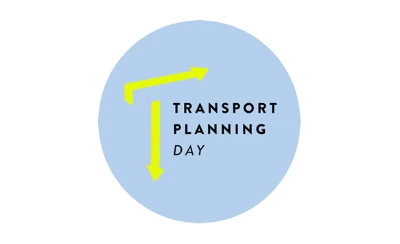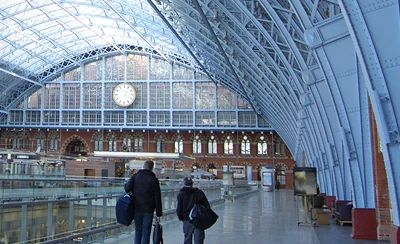Q&A from David Metz following the launch of his new book: ‘Good to Go: Decarbonising Travel After the Pandemic’
Back in October last year, if you can cast your mind back that far, the TPS held a brilliant event launching David Metz’s new book: ‘Good to Go: Decarbonising Travel After the Pandemic’. The book launch and subsequent panel discussion inspired so much conversation that the aftermath has seen the TPS team inundated with follow up questions from attendees. In this blog David Metz has kindly taken the time to respond to some of these questions.
In case you missed the event, you can watch the recording on the TPS YouTube channel here, and when purchasing the book make sure to take advantage of the exclusive 30% discount for TPS members.

Q1: You spoke a lot about the power of digital navigation tools to influence the use of the network, particularly as their ubiquity has grown so much in recent years and is likely approaching saturation levels. I have a few questions on this:
a. You note the power of the ‘estimated time of arrival’ as a function in both providing reassurance and likely increasing satisfaction in the road network for users who typically value reliability over speed. Are you aware of the levels of accuracy that these systems achieve and what may influence that? Are there any independent studies seeking to verify this?
My recent paper discusses the impact of Digital Navigation. I am not aware of any studies of the relative accuracy of ETAs from different Digital Navigation providers. But there is a very interesting paper from DeepMind, an associate business of Google, here.
b. I’m very interested in the idea of this being not just a tool for optimising route choice but also in influencing travel behaviour more fundamentally, e.g. nudging people to travel at different times, by different routes and even different modes. Perhaps even building in a ‘social impact score’ where your choice could be optimised to reduce impacts on other road users (e.g. avoiding residential roads). How far do you think this could be pushed? Does it have more applicability for less frequent/habitual leisure vs commuter trips do you think?
I agree that using Digital Navigation to nudge people to make better use of the road network would be well worth exploring. There is relevant traffic theory – Wardrop’s two equilibria – which I am exploring.
c. We discussed the fact that people don’t really think of there being a cost/mile of motoring at present. But via fuel duty, parking, and perhaps a clever apportionment of sunk costs, there is. Could this be effectively built into these sort of systems to start getting some of the gains that road user charging promises?
One could imagine a Digital Navigation service that offered lowest fuel cost routing.
d. Is there a risk that optimisation at a strategic scale could lead to induced traffic?
Yes, in that making better use of available capacity would allow more trips to be made. But regulation of Digital Navigation could prevent use of environmentally unsuitable minor roads.
e. You noted that there wasn’t a huge level of interest at the DfT level on this. What would you do next to move this on? Perhaps a Transport Select Committee investigation or a policy paper working with institutions? Do you have any particular insight in how best to incentivise LAs to work with providers (and vice versa)? (Incidentally, as an LA that desperately wanted to work with google etc. on this when putting in road closures, it was a complete black box and very difficult to get any real engagement).
GoogleMaps seems uptight. But Waze is open to collaboration and TomTom offers an O/D service. I’m not sure how to convert DfT to switch from focussing on investment in new capacity to making better use of existing network. Topic for TPS to pursue perhaps?
Q2: There’s a good section in your book about changing generational trends for driving behaviour, and whilst the conclusion I took was that I was too early to attribute genuine changes in travel behaviour and mode choice amongst younger people, do you broadly agree that car use in younger populations is different from older age groups? We didn’t get a chance to discuss the idea of how to work with those newly incoming into the market for car trips to influence mode choice, e.g. via regulations like graduated driver licenses, mandating the need for pay/mile insurance provision etc? This would seem an approach that could be less contentious then trying to upend established habits by older car users?
Not clear if the trend by younger adult to make less use of the car is long term, or whether it reflects the postponement of entry to adult life, the result of longer education, later child bearing etc. Also, the pandemic has made car ownership more attractive, but again not clear if this is more than a short-term effect.
Q3: You raise a number of concerns about relying on journey time savings as a basis for making investment decisions, concerns which are shared by many in the Society and which we have been communicating over many years. The solution you propose is to move towards Access Planning, with a greater focus on observed values of real estate as a way of working out benefits. Putting yourself in the seat of a critic of this approach, what do you think the main problems are and perhaps why it hasn’t been deployed to date? Thinking more positively, do you think the push for 15 minute neighbourhoods gives new life to this agenda, and that this may have a significant impact on travel behaviour in the longer term if embraced and embedded in policy?
I am working on a new book for an academic publisher, the core of which is a critique of conventional transport economics and associated modelling. I will need to discuss alternatives, including valuing access benefits and real estate values. I could talk to TPS about emerging findings next year. The problem with 15 minute neighbourhoods is that people move to cities to escape the limited possibilities of villages; that the urban built environment is a given, with much of it valued for visual qualities (conservation areas etc), and is largely in private ownership. So the scope for planners to reduce travel is quite limited.
Q4: We talked a bit about whether we could ever appraise in common terms the transport benefits of widening a road, putting in a cycle lane, or opening a corner shop in an area that has a deficit of such services. To a certain extent this is the idea of ‘Triple Access Planning’. Whilst this will take a long time to change travel behaviour at scale, it feels necessary to break out of the idea of transport as needing to solve all its own problems, even as we constantly recognise that we are a derived demand. I also note a Rory Sutherland throw away that the best value transport investment may well have been to have bought every resident of the country a Zoom professional licence etc… What innovation in governance could be useful here? For example, I’m told that the Finnish have a single agency for all communications, digital or actual and therefore look at such investments in the round. Could this help in the UK, or is this a red herring?
There has been long running debate about whether digital communications could replace travel (as certainly happened during the pandemic) or whether it promotes travel by fostering more extensive social and business networks, whom we like to meet in person from time to time. The jury is out, but the hour a day invariant travel time phenomenon suggests that the total amount of travel may be hard to change.
Q5: We spoke a lot about the relative role of active travel vs electric vehicles in delivering carbon savings. Whilst it is clear that is a small role, I’m not sure we properly explored the embodied carbon element of Ev’s. Do you think this changes the equation at all?
The implication of Net Zero by 2050 is that everything will be decarbonised by then, including all the materials to make an EV. A difficult task, of course, but big efforts are being made to switch to renewables and hydrogen.
Q6: I was really interested in the idea of treating the strategic road network as a mature system for optimisation rather than expansion, not unlike its urban counterpart. I wonder what this would look like in practice? Would this mean a proper focus on reliability as a key indicator over overall journey time? I know this was a technique that TfL focussed on during Boris Johnson’s term as mayor, however I think the jury is still out on whether it led to any major change of actual approach. Would this mean more managed motorways (by that I mean more the bit or smart motorways that seeks to influence speeds to maintain flow rather than removing hard shoulders)? What do you think a business case for this approach would like? For example, I was particularly taken by your assessment that the impact of induced traffic on safety completely outweighs most safety benefits of new alignments that increase capacity. Could this deliver a positive BCR all on its own? How could reliability be better valued in appraisal? Could it put more focus on demand management, e.g. car occupancy improvements? As someone who led formal objection to the removal of the M4 bus lane, with the suggestion that it was something that could have been morphed into a HOV lane I always thought this was a missed opportunity - could we do more on this e.g. like High Occupancy toll lanes? Would it support a greater focus on resilience, surely necessary in coming years?
I suspect there is much potential to optimise both urban and inter-urban road networks, taking advantage of Digital Navigation and other digital technologies, although the detailed possibilities are beyond my area of expertise. Generally, well-conceived digital investments are likely to be far more cost-effective in achieving desired outcomes, such as reliability, than civil engineering investments.
Q7: I have mentioned a number of times that induced traffic will result from a shift to EVs without some replacement for fuel duty, given lower marginal cost of travel. However you think there is likely to be no rebound effect given travel time budget. How certain can you be about this?
My analysis is that per capita car use (km/pa) depends mainly on three factors: time available for travel, speed of travel, and household car ownership. None would be much affected by lower fuel costs, so I don’t expect to see much of a rebound effect.
Q8: I was very much taken by your assessment that hen parties and stag dos are half of flights by young men, and a third by young women! I wasn’t sure what proportion of total flights that was, but clearly it suggests a possible role in managing demand as well as pursuing technological fixes (particularly whilst we have so many polluting planes in the sky). People have come to expect a right to fly, and so limiting access for all, e.g. by price, when it’s actually the comparatively wealthy frequent flyers that cause the majority of emissions feels regressive though. Would a frequent flyer levy help in this situation do you think? As you infer, the economic cost of such a policy could be net positive if money is spent in UK? I also found the Japanese experience of demand plateaus linked to demographics, do you think this sort of demand saturation linked to ageing is properly considered in aviation forecasts?
There is scope for managing demand for air travel through taxation, whether APD or fuel tax or extending the carbon trading scheme. APD might depend on how many trips had been made, although higher rates would be born by business users, whose demand might not be very elastic. If we do not add to airport capacity, the eventual capacity constraint would lead to higher charges levied by airports, which would limit demand, particularly from lower value trips like stage parties.
Q9: It’s clear that working from home has increased since the pandemic, though your contention is that overall trip making will remain constant to match the travel time budget. Do you fear the replaced commuter trips will be disproportionately car heavy? Do you think the traditional focus on planning for the commute leaves us vulnerable here?
Too early to say what the longer term effect of more working from home has on travel patterns. The National Travel Survey for 2022 should be informative.
Q10: You mentioned a number of times about the role of parking policy in influencing travel behaviour. What do you think local government could do better here, and how should central government support that? (e.g. workplace parking level support).
Parking, both public availability and charges, can be varied incrementally and so may be an easier way of reducing car use than measures that make a bigger impact, e.g. LTNs. Constraints on kerbside parking can be presented as helping keeping the traffic flowing. You will know better than I whether it would be better for local government to be up-front with parking policy, or low key. It may depend on how secure the political party in control is; introduction of the Nottingham workplace parking levy was helped by the fact that Labour felt secure.
Q11: I was also really taken with the section in the book contrasting the legal basis for clean air vs the economic basis of road safety. Given the striking successes by outfits like Client Earth in pushing action in this space through the courts on clean air, can you see benefits for proponents of vision zero if this also became law?
I think Vision Zero would be hard to enforce by law, beyond a ‘best endeavours’ type of duty. Any legal basis would create opportunities for litigation by activists. The question is whether the economic case for tackling detriments is better than the legal approach. Given the deployment of EVs, I think there was a case for not introducing legally enforceable CAZs in the more marginal cases of air pollution.
Q12: Roger Geffen made a useful comment during the event I thought on the challenges in tackling car use and congestion. His point was that a congestion charge, when coupled with investment in public transport and reallocation of road space to support active travel, does appear to have neutered induced demand in central and inner London to some extent. The key seems to be the interplay of the demand and supply elements. Could this not work on a national basis in terms of road user charging?
The congestion charge applies only to a small central zone and the charge is not high enough to deter business users or well off private motorists. What has limited the growth of car use in London has been the road capacity, of which that available for general traffic has been reduced by bike and cycles lanes. At the same time, the population has been growing and there has been investment in rail and buses. So London is a good model for other cities. To limit car use nationally by road user charging would require levels of charge that would be politically difficult to introduce, in my view. Road user charging for EVs probably could not be greater than fuel tax paid by IC vehicles.
Q13: In your book you make the point that there are no professional standards for modellers. But we do have a TPS code of conduct. What more should we do on this?
You would need a means to enforce the code of conduct. For instance, the actuaries (with whom I have had past involvement and who use complex models) have in place formal standards (e.g. like this) and a disciplinary procedure, which is being updated here. If a complaint is made about the conduct of an actuary, a panel of experienced practitioners decides whether there has been a shortcoming in relation to the standards.
Q14: You make the excellent point about EVs embedding inequality in your book. It seemed to me to help make the case for a means tested EV grant? Or a subsidized vehicle available for low income households, enabled by a joint procurement? You see in the energy market joint procurement exercises undertaken by local and regional government to help secure economies of scale and best value. Could the same be done with cars?
In the current climate for public expenditure, I would not expect subsidy for EVs to be a priority. We’ll have to wait for the second-hand market to grow naturally.
Q15: There was a striking phrase for me in your book, paraphrased as “much of our travel isn't necessary, but we like it and so we do it” (pg. 144). Do you see any scope for us as policy makers to get to a point where we facilitate the necessary, but discourage the optional or discretionary, (or better shift onto sustainable modes)?
Not sure that we can usefully make a distinction between necessary travel and optional. Mode choice is discreet, but distance travelled is a function of time and money costs set against value of access to the destination. Mode shift is possible to effect with sticks and carrots, as in London.
Q16:How hopeful are you that citizen assemblies can cut through the political challenges and deliver an impetus for change? Are these best done at national rather than local level? Or both depending on question?
Citizen assemblies can reach sensible conclusions, which can encourage politicians to implement them. But the electorate as a whole do not undergo the process of information gathering and debate from which the assembly participants benefitted, so politicians are inevitably cautious.







